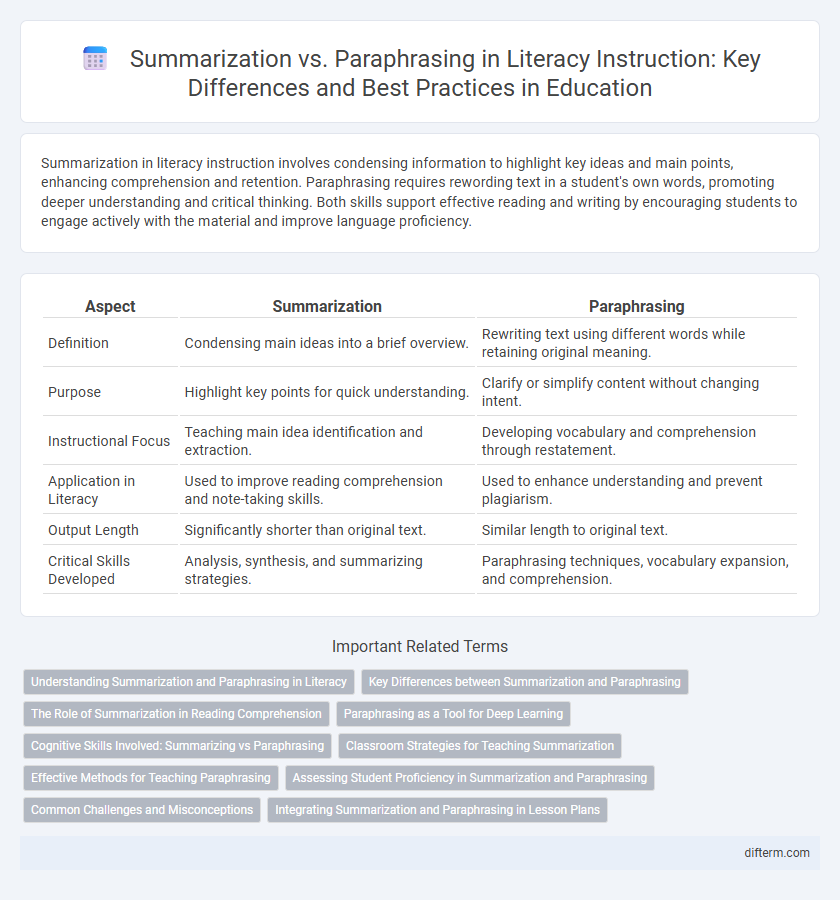Summarization in literacy instruction involves condensing information to highlight key ideas and main points, enhancing comprehension and retention. Paraphrasing requires rewording text in a student's own words, promoting deeper understanding and critical thinking. Both skills support effective reading and writing by encouraging students to engage actively with the material and improve language proficiency.
Table of Comparison
| Aspect | Summarization | Paraphrasing |
|---|---|---|
| Definition | Condensing main ideas into a brief overview. | Rewriting text using different words while retaining original meaning. |
| Purpose | Highlight key points for quick understanding. | Clarify or simplify content without changing intent. |
| Instructional Focus | Teaching main idea identification and extraction. | Developing vocabulary and comprehension through restatement. |
| Application in Literacy | Used to improve reading comprehension and note-taking skills. | Used to enhance understanding and prevent plagiarism. |
| Output Length | Significantly shorter than original text. | Similar length to original text. |
| Critical Skills Developed | Analysis, synthesis, and summarizing strategies. | Paraphrasing techniques, vocabulary expansion, and comprehension. |
Understanding Summarization and Paraphrasing in Literacy
Summarization in literacy instruction involves condensing main ideas and essential details from a text into a concise overview, enhancing students' comprehension and retention of key information. Paraphrasing requires rewriting the original text in one's own words while maintaining the original meaning, which deepens understanding and encourages active engagement with the material. Both skills are critical for developing literacy, as summarization emphasizes synthesis of core concepts, and paraphrasing supports interpreting and clarifying content.
Key Differences between Summarization and Paraphrasing
Summarization condenses the main ideas of a text into a brief overview, emphasizing core points while omitting details, whereas paraphrasing involves rewording the original content in a new way without shortening its length significantly. Summarization requires identifying and extracting essential information to create a concise version, while paraphrasing demands maintaining full meaning and nuances but changing vocabulary and sentence structure. Both strategies are critical in literacy instruction for developing comprehension and writing skills but serve distinct purposes in processing and representing text.
The Role of Summarization in Reading Comprehension
Summarization plays a crucial role in reading comprehension by helping students distill essential ideas from complex texts, enhancing their ability to retain and understand key information. Effective summarization techniques promote active engagement with the material, encouraging learners to identify main points and ignore irrelevant details. This process supports the development of critical thinking skills and aids in the synthesis of knowledge across various literacy domains.
Paraphrasing as a Tool for Deep Learning
Paraphrasing in literacy instruction enhances comprehension by requiring students to restate text using their own words, promoting deeper cognitive engagement with the material. This active processing aids in the consolidation of knowledge and supports critical thinking skills essential for academic success. Unlike summarization, paraphrasing demands a more thorough understanding, making it an effective tool for fostering long-term retention and meaningful learning.
Cognitive Skills Involved: Summarizing vs Paraphrasing
Summarizing in literacy instruction involves identifying main ideas and condensing information, which enhances skills like synthesis and abstraction. Paraphrasing requires rewording the original text while maintaining meaning, engaging comprehension and linguistic flexibility. Both strategies develop critical thinking but target different cognitive processes, with summarizing emphasizing distillation and paraphrasing focusing on interpretation.
Classroom Strategies for Teaching Summarization
Effective classroom strategies for teaching summarization emphasize guiding students to identify main ideas and key details while omitting extraneous information, enhancing comprehension and retention. Utilizing graphic organizers and explicit modeling helps students practice condensing text into concise summaries, fostering critical thinking and synthesis skills. Regular feedback and collaborative activities support the development of summarization proficiency, distinguishing it from paraphrasing, which involves rewording without significantly shortening the content.
Effective Methods for Teaching Paraphrasing
Effective methods for teaching paraphrasing in literacy instruction emphasize explicit modeling and guided practice to develop students' ability to restate content accurately while preserving meaning. Incorporating strategies such as using synonyms, altering sentence structure, and focusing on key concepts helps learners understand how to avoid plagiarism and improve comprehension. Scaffolded activities, including collaborative paraphrasing exercises and immediate feedback, enhance students' skills in producing original renditions of texts.
Assessing Student Proficiency in Summarization and Paraphrasing
Assessing student proficiency in summarization involves evaluating their ability to identify and condense key ideas while maintaining the original text's meaning. In contrast, proficiency in paraphrasing is measured by how effectively students can restate the content using different words and sentence structures without altering the intended message. Effective literacy instruction incorporates rubrics that differentiate these skills, focusing on comprehension, accuracy, and language use to ensure students develop critical reading and writing competencies.
Common Challenges and Misconceptions
Summarization and paraphrasing often pose challenges in literacy instruction due to students' difficulty distinguishing between the two tasks, frequently leading to verbatim copying instead of condensing or rephrasing content. Common misconceptions include the belief that paraphrasing requires changing only a few words or that summarization involves including all details, which undermines critical comprehension and synthesis skills. Effective teaching strategies emphasize understanding the purpose of each skill: summarization to capture main ideas succinctly and paraphrasing to restate information accurately in one's own words.
Integrating Summarization and Paraphrasing in Lesson Plans
Integrating summarization and paraphrasing in literacy lesson plans enhances students' comprehension and critical thinking by encouraging them to distill key ideas and express concepts in their own words. Effective instruction involves modeling both techniques, providing guided practice with varied texts, and incorporating scaffolded activities to build autonomy in information processing. Utilizing digital tools and peer collaboration can further reinforce these skills, promoting deeper engagement with content and improved retention.
Summarization vs Paraphrasing (in literacy instruction) Infographic

 difterm.com
difterm.com